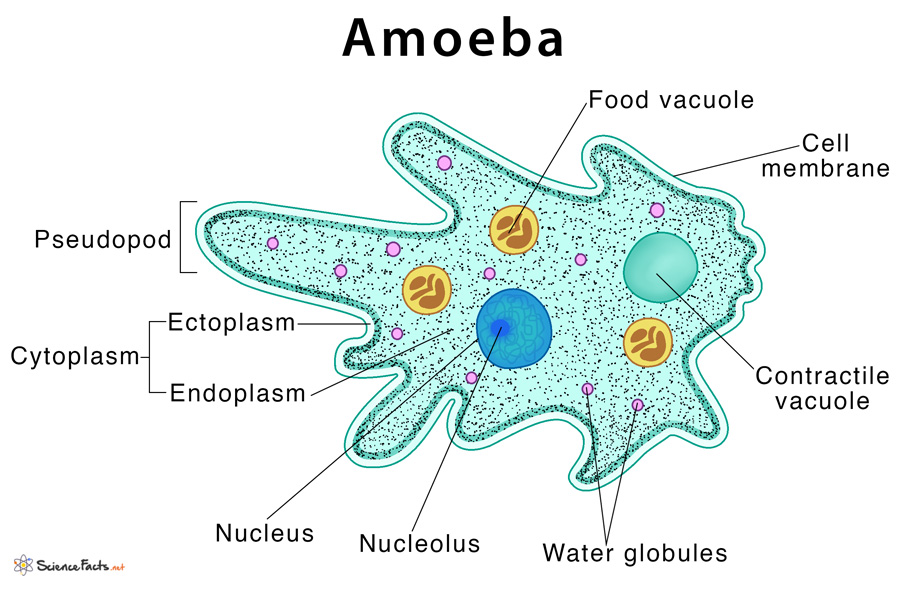The term ‘amoeba’ is derived from the Greek word ‘amoibe’ meaning ‘change’. German naturalist August Johann Rösel von Rosenhof discovered and described amoeba in 1755.
How Do They Eat
They catch food such as algae, bacteria, plant cells, microscopic protozoa, and metazoans through absorption using pseudopodia, a process termed phagocytosis. This mode of nutrition in amoeba is called holozoic nutrition where the food particles are engulfed to form a vacuole around it. Other Important Features:
Takes in oxygen and gives out carbon dioxide across the cell membrane through diffusion, which helps to produce energy in the form of ATPExchanges water, ions and other small molecules across its cell membrane using the process of osmosisHas an average life span of 2 daysUnder unfavorable growing conditions, it transforms into a protective ball called the microbial cyst
How Big Can it Get
It varies widely in size and shape from being extremely small between 2.3 – 3.0 µm to exceptionally large such as 20 cm in diameter. The so-called ‘giant amoebae’, Pelomyxa palustris and Chaos carolinense, can be as large as 5 mm.
Its Parts
- Cell membrane: Also called plasmalemma, it is a thin-layered membrane composed of protein and lipid molecules that restricts the entry and exit of substances in and out of the cell.
- Cytoplasm: A mass of a jelly-like substance that holds all the other organelles. It consists of two parts: a) Ectoplasm: The outer gelatinous, semi-solid layer called plasmagel, found just beneath the cell membrane. b) Endoplasm: The less viscous fluid called plasmasol that surrounds the ectoplasm.
- Nucleus: Small region within the cytoplasm that contains the genetic material or DNA in the form of chromatin granules along with the nucleoplasm, held within the nuclear membrane.
- Pseudopod: Also called false feet, it is a temporary arm-like cytoplasmic extension that helps amoeba to perform locomotion and capture food. There can be multiple pseudopods in a cell, together known as pseudopodia.
- Contractile vacuole: A clear transparent body filled with a watery fluid, found in the outer part of the endoplasm. The food captured using pseudopodia are digested, and the wastes are expelled using contractile vacuoles. It also helps to maintain proper water and salt concentrations within the organism.
- Food vacuole: Different-sized vacuoles that help in the digestion of food. There are multiple food vacuoles unevenly scattered in the cytoplasm.
- Water globules: Several small, spherical, colorless, and non-contractile vacuoles filled with water that helps to store water and essential minerals. Binary Fission: The most common mode of reproduction in amoeba, where the parent cell divides equally to distribute its content into two daughter cells. This is the reason why amoeba is called immortal, as the parent cell itself lives on in the daughter cells, which will then give rise to more amoeba cells. Multiple Fission: Occurs under unfavorable conditions where the parent cell undergoes multiple divisions to form 500- 600 daughter cells. Sporulation: It is the inactive phase of reproduction during which the nucleus of amoeba undergoes multiple divisions to form numerous spores. Under favorable conditions of growth, the spores germinate back into reproductive cells. This is an important form of adaptation in amoeba. Regeneration: A part of the amoeba’s body having a fragment of its nucleus develops into a completely new organism.
